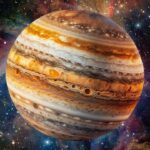
📷 Image Credits: The Hindu
Two massive asteroids, one of them discovered earlier in June, passed by the Earth this week, coincidentally aligning with the celebration of International Asteroid Day on June 30. These celestial events, documented by space agencies worldwide, brought attention to the need for continued vigilance in monitoring potentially hazardous objects in our cosmic neighborhood.
The first asteroid, named 2024 MK, boasted a diameter of around 200 meters and came within 300,000 kilometers of Earth – approximately 77% of the distance to the Moon. Dr. Gianluca Masi, an astrophysicist, provided commentary during a live stream, emphasizing the exceptional nature of the celestial fly-by. The asteroid hurtled past at an average speed of nine meters per second, making it a compelling sight for observers in specific regions.
The second asteroid, known as (415029) 2011 UL21, was even larger, measuring 2.3 kilometers across. Despite its substantial size, it posed no threat to Earth, passing at a safe distance of 6.6 million kilometers. This asteroid’s encounter marked it as one of the top ten largest ones to approach Earth’s distance since 1900.
These fly-bys coincide with ongoing efforts in planetary defense, with the European Space Agency (ESA) announcing the upcoming Hera mission in October 2024. This mission aims to conduct a detailed post-impact survey of an asteroid targeted by NASA’s Double Asteroid Redirection Test (DART) mission in 2022. Such initiatives highlight the collaborative global endeavors in safeguarding Earth from potential cosmic hazards.
Astronomers and researchers, including Chrisphin Karthick from the Indian Institute of Astrophysics, stress the importance of identifying and tracking asteroids to mitigate risks of collision. As technology advances, our capacity to detect and characterize near-Earth objects grows, offering hope for enhanced planetary defense in the future. The serendipitous timing of these asteroid encounters serves as a poignant reminder of the cosmic wonders and potential threats that surround our home planet.







